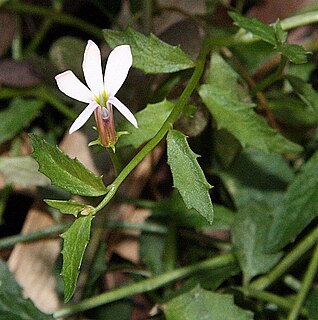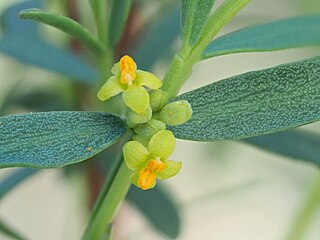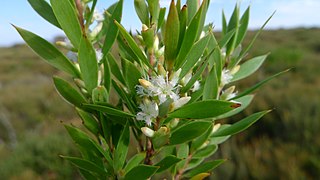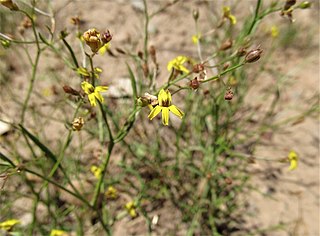
Pimelea humilis, also known as common riceflower or dwarf riceflower, is a shrub in the family Thymelaeaceae, native to Australia. It grows up to 0.5 metres in height. Flowerheads have 12 to 52 whitish flowers that are either female or bisexual. The leaves are 5 to 15 mm long and 2 to 8 mm wide.

Pimelea flava is a shrub in the family Thymelaeaceae which is endemic to Australia.

Lobelia purpurascens, commonly known as white root or purplish pratia, is a flowering plant in the family Campanulaceae of eastern Australia. It is a small herbaceous, scrambling plant with white to pale pink flowers.

Dampiera stricta commonly known as blue dampiera, is a flowering plant in the family Goodeniaceae. It is a small sub-shrub with variable leaves and mostly blue, mauve or purple flowers.

Persicaria decipiens, commonly known as slender knotweed, is a species of flowering plant native to Australia and Asia.

Pimelea pauciflora, commonly known as poison rice-flower, is a species of shrub in the family Thymelaeaceae. It has small yellow-lime flowers, green, smooth fleshy leaves and is endemic to Eastern Australia.

Leucopogon affinis, commonly known as lance beard-heath and formerly known as Leucopogon lanceolatus is a flowering plant in the heath family Ericaceae and is endemic to eastern Australia, including Tasmania and South Australia. It is an erect shrub with spikes of small white flowers in early spring, followed by orange-red fruit.

Goodenia stelligera, commonly referred to as spiked goodenia, is a species of flowering plant in the family Goodeniaceae and is endemic to near-coastal areas of eastern Australia. It is an erect herb with linear to lance-shaped leaves, sometimes with toothed edges, and racemes or thyrses of hairy yellow flowers.

Leucopogon esquamatus, commonly known as the swamp beard-heath, is a species of flowering plant in the heath family Ericaceae and is endemic to south-eastern Australia. It is a slender shrub with mainly elliptic leaves, and short-lived white, tube-shaped flowers arranged singly or in pairs in upper leaf axils.

Pimelea angustifolia, commonly known as narrow-leaved pimelea, is a small upright, slender or open shrub with whitish, cream, yellow or pink flowers. It is endemic to Western Australia.

Pimelea curviflora, also known as curved rice-flower, is a shrub in the family Thymelaeaceae and is endemic to Australia. It is a small, hairy shrub with greenish-yellow or red tubular flowers.

Goodenia gracilis, commonly known as slender goodenia, is a species of flowering plant in the family Goodeniaceae and is endemic to Australia. It is an annual or perennial herb with linear to lance-shaped leaves and racemes of yellow flowers.
Chloanthes glandulosa is a species of flowering plant in the family Lamiaceae. It is a small shrub with wrinkled leaves and greenish-yellow tubular flowers. It is endemic to New South Wales.

Epacris crassifolia is a species of flowering plant in the heath family Ericaceae and is endemic to south-eastern New South Wales, Australia. It is a low-lying shrub with elliptic to egg-shaped leaves with the lower end towards the base, and tube-shaped, white or cream-coloured flowers clustered near the ends of the branches.

Leucopogon appressus is a species of flowering plant in the heath family Ericaceae and is endemic to south-eastern New South Wales. It is a small, spreading to erect shrub with wiry stems, lance-shaped or narrowly egg-shaped to elliptic leaves and small white flowers.

Leucopogon australis, commonly known as spiked beard-heath, is a species of flowering plant in the heath family Ericaceae and is endemic to southern Australia. It is an erect, aromatic shrub with narrowly egg-shaped to narrowly elliptic leaves, and white flowers arranged in spikes near the ends of branchlets.

Leucopogon collinus, commonly known as fringed beard-heath, is a species of flowering plant in the heath family Ericaceae and is endemic to south-eastern Australia. It is a slender, erect or spreading shrub with narrowly lance-shaped leaves, and white, tube-shaped, bearded flowers.

Pimelea argentea, commonly known as silvery leaved pimelea, is a species of flowering plant in the family Thymelaeaceae and is endemic to the south-west of Western Australia. It is an erect shrub with densely hairy young stems and leaves, the leaves linear to elliptic, and heads of white to yellow or greenish flowers, the male and female flowers on separate plants.
Pimelea brevifolia is a species of flowering plant in the family Thymelaeaceae and is endemic to the south-west of Western Australia. It is an undershrub or shrub with erect, elliptic leaves, and heads of white flowers surrounded by four involucral bracts.
Pimelea cinerea is a species of flowering plant in the family Thymelaeaceae and is endemic to Tasmania. It is a slender shrub with more or less elliptic leaves, and heads of white flowers surrounded by leaves.



















